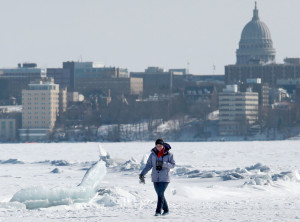
Kayla Powell of Lacrosse makes her way past a collection of ice heaves on Lake Mendota in February. With this month’s warm temperatures, it could be a while before the lake freezes again. Photo credit: John Hart, State Journal archives
The climatological ice-on date for Mendota is Dec. 19 but the actual ice-on date in any given winter is highly variable. Given our warm autumn this year, it is likely we will experience a later than normal ice-on date.
Right now the lake’s water temperature is about 7C (45 degrees Fahrenheit) and, importantly, that temperature is nearly uniform throughout the water column. Such uniformity in temperature started about Oct. 1 this year, according to data from the Integrated Nowcast/Forecast Operation System (INFOS) for the Yahara Lakes (www.infosyahara.org/temp_mendota). At that time, the water temperature was about 15C (59 Fahrenheit). Thus, in the past two months, the lake water has cooled by 8C (14 degrees Fahrenheit).
Such cooling requires an enormous amount of energy to be extracted from the lake. Knowing the size of the lake (39.85 million square meters), its average depth (12.7 meters) and the density of water (1000 kg per cubic meter), we know that 507 billion kg of water reside in Lake Mendota. Given the 14-degree temperature change and the fact that 4200 joules of energy must be extracted from each kilogram of water to lower its temperature 1C, we know that 1.7 quadrillion joules of energy have been extracted from the lake since Oct. 1.
Since there are 3.6 million joules in every kilowatt hour (kwH) and the Madison metro area uses about 79 million kwH of energy on a typical January day, we can calculate that the amount of energy thus far extracted from Lake Mendota to get it to its current temperature is enough to power the entire Madison metro area for nearly 60 winter days.
Additionally, it is not until the water temperature cools another 3C (requiring extraction of the equivalent of another 23 days of energy) that the lake is even ready for the additional surface cooling that eventually leads to freezing. It is easy to overlook the fact that truly enormous amounts of energy are being transferred from water to atmosphere before our eyes.

